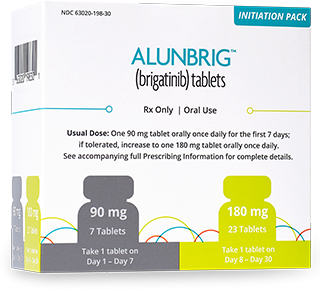
Choose ALUNBRIG® (brigatinib): Once-Daily Dosing That Fits Into Patients' Lives1
ALUNBRIG: Dosing That Fits Into Patients’ Lives1
The recommended dosage for ALUNBRIG is 90 mg orally once daily for the first 7 days; then increase the dose to 180 mg orally once daily.1
- Administer ALUNBRIG until disease progression or unacceptable toxicity
- If ALUNBRIG is interrupted for 14 days or longer for reasons other than adverse reactions, resume treatment at 90 mg once daily for 7 days before increasing to the previously tolerated dose
- ALUNBRIG may be taken with or without food. Instruct patients to swallow tablets whole. Do not crush or chew tablets
- Inform patients to avoid grapefruit or grapefruit juice while taking ALUNBRIG
- If a dose of ALUNBRIG is missed or vomiting occurs after taking a dose, do not administer an additional dose and instruct patients to take the next dose of ALUNBRIG at the scheduled time
ALUNBRIG is available in 180-mg, 90-mg, and 30-mg tablets. They must be stored at controlled room temperature of 68°F to 77°F (20°C to 25°C).1
Dosing Guide
Once-daily dosing can substantially reduce a patient's pill burden1
up to 365 tablets / capsules a yeara
up to 730 tablets / capsules a yeara
up to 2,920 tablets / capsules a yeara
aRecommended dose.
Special Considerations for Patients1
- Advise patients to avoid grapefruit or grapefruit juice
- Advise patients to limit sun exposure
- Advise females and males with female partners of reproductive potential of the potential risk to a fetus and to use effective contraception
Find Out if ALUNBRIG Is Right for Your Patients
The ALUNBRIG SMART™ Program can help you and your patients with ALK+ mNSCLC assess whether ALUNBRIG is right for them by offering a 1-month free trial.
ALUNBRIG SMART Program
Discover whether ALUNBRIG is right for your patient with a 1-month free trial
A Smart Way to Start Patients on ALUNBRIG
Order the ALUNBRIG Initiation Pack

To support patients starting therapy, the ALUNBRIG Initiation Pack contains the first month’s supply of the recommended dosage.
• 1 bottle of 90-mg tablets (7 count)
• 1 bottle of 180-mg tablets (23 count)
Important Considerations
Drug Interactions1
- Avoid coadministration with strong or moderate CYP3A inhibitors. If coadministration of a strong or moderate CYP3A inhibitor cannot be avoided, reduce the dose of ALUNBRIG
- Avoid coadministration with strong or moderate CYP3A inducers. If coadministration of moderate CYP3A inducers cannot be avoided, increase the dose of ALUNBRIG
Special Populations1
- Pregnancy: ALUNBRIG can cause fetal harm. Advise females of reproductive potential of the potential risk to a fetus
- Lactation: There are no data regarding the secretion of ALUNBRIG in human milk or its effects on the breastfed infant or milk production. Because of the potential for adverse reactions in breastfed infants, advise lactating women not to breastfeed during treatment with ALUNBRIG and for 1 week following the final dose
- Females and Males of Reproductive Potential: Verify pregnancy status in females of reproductive potential prior to initiating ALUNBRIG. Advise females of reproductive potential to use effective contraception during treatment and for at least 4 months after the final dose. Advise males with female partners of reproductive potential to use effective contraception during treatment and for at least 3 months after final dose. ALUNBRIG may cause reduced fertility in males
- Pediatric: The safety and effectiveness of ALUNBRIG in pediatric patients have not been established
- Geriatric: Of the 359 patients enrolled in the ALTA 1L ALUNBRIG arm and in ALTA, 26.7% were 65 and older and 7.5% were 75 and older. No overall differences in safety or effectiveness were observed between patients ≥65 years and younger patients
- Hepatic and Renal Impairment: No dose adjustment is recommended for patients with mild or moderate hepatic impairment or mild or moderate renal impairment. Reduce the dose of ALUNBRIG for patients with severe hepatic impairment or severe renal impairment
Avoid Coadministration of Strong or Moderate CYP3A Inhibitors During Treatment With ALUNBRIG1
- If coadministration of a strong CYP3A inhibitor cannot be avoided, reduce the ALUNBRIG once-daily dose by approximately 50% (ie, from 180 mg to 90 mg, or from 90 mg to 60 mg)
- If coadministration of a moderate CYP3A inhibitor cannot be avoided, reduce the ALUNBRIG once-daily dose by approximately 40% (ie, from 180 mg to 120 mg, 120 mg to 90 mg, or from 90 mg to 60 mg)
- After discontinuation of a strong or moderate CYP3A inhibitor, resume the ALUNBRIG dose that was tolerated prior to initiating the CYP3A inhibitor
Avoid Coadministration of Moderate CYP3A Inducers During Treatment With ALUNBRIG1
- If coadministration of a moderate CYP3A inducer cannot be avoided, increase the ALUNBRIG once-daily dose in 30-mg increments after 7 days of treatment with the current ALUNBRIG dose as tolerated, up to a maximum of twice the ALUNBRIG dose that was tolerated prior to initiating the moderate CYP3A inducer
- After discontinuation of a moderate CYP3A inducer, resume the ALUNBRIG dose that was tolerated prior to initiating the moderate CYP3A inducer
For patients with severe hepatic impairment, reduce the ALUNBRIG once-daily dose by approximately 40% (ie, from 180 mg to 120 mg, from 120 mg to 90 mg, or from 90 mg to 60 mg) for patients with severe hepatic impairment (Child-Pugh C).1
For patients with severe renal impairment, reduce the ALUNBRIG once-daily dose by approximately 50% (ie, from 180 mg to 90 mg, or from 90 mg to 60 mg) for patients with severe renal impairment [creatinine clearance (CLcr) 15 to 29 mL/min by Cockcroft-Gault].1
Dosage Modifications
Recommended Dosage Reductions1
- Once reduced for adverse reactions, do not subsequently increase the dose of ALUNBRIG® (brigatinib)
- Permanently discontinue ALUNBRIG if patients are unable to tolerate the 60-mg once-daily dose
Patient Treatment Guide
Recommended Dosage Modifications1
aGraded per National Cancer Institute Common Terminology Criteria for Adverse Events. Version 4.0 (NCI CTCAE v4.0).
ALT, alanine aminotransferase; ALK, anaplastic lymphoma kinase; ALK+ ALK-positive; AST, raised aspartate aminotransferase; bpm, beats per minute; CYP3A, cytochrome P450, family 3, subfamily A; DBP, diastolic blood pressure; HR, heart rate; NSCLC, non-small cell lung cancer; SBP, systolic blood pressure; ULN, upper limit of normal.